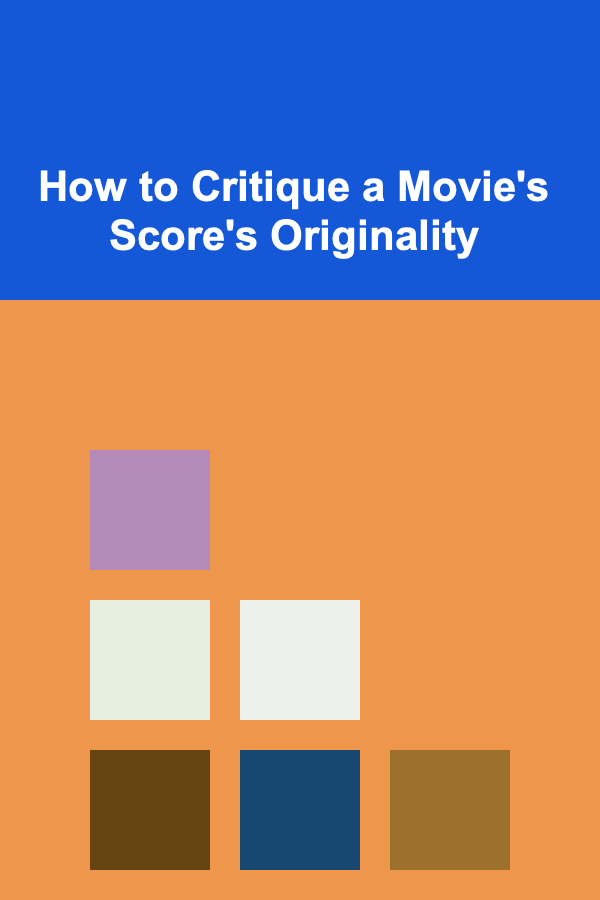
How to Critique a Movie's Score's Originality
ebook include PDF & Audio bundle (Micro Guide)
$12.99$8.99
Limited Time Offer! Order within the next:

Critiquing a movie's score goes beyond analyzing the emotional tone and ambiance it creates within the film. One of the essential aspects of a film's score, however, is its originality. The score is not only meant to enhance the narrative or atmosphere of the film but also serve as an artistic expression that can stand on its own. This article explores the nuances of critiquing a film score's originality, focusing on key aspects such as the use of themes, motifs, instrumentation, and the composer's approach to music.
To analyze the originality of a film score, we must understand what defines musical creativity and how it plays out within the medium of film. A score's originality is crucial for distinguishing a film's identity and ensuring that the music feels fresh, distinct, and integral to the film's artistic vision.
Understanding the Role of a Film Score
Before critiquing the originality of a film score, it's important to understand its role in the cinematic experience. A film score serves multiple purposes, including:
- Enhancing the narrative: A good score can amplify a film's storyline by reinforcing emotional beats, providing cues to the audience about the emotional undercurrent, and reinforcing themes and character arcs.
- Establishing atmosphere: Music is a powerful tool in establishing the tone of a film. Whether it's a dramatic score that heightens tension or a lighthearted theme that evokes joy, the score is central in guiding the audience's emotional response to the visuals.
- Character development: Many film scores introduce musical motifs or themes associated with specific characters. These motifs help to deepen the viewer's connection to the characters by providing a musical reflection of their journey.
- Innovative artistic expression: On a more abstract level, the score allows composers to express themselves artistically. Music can become an essential part of the film's identity, helping to separate it from others within the same genre or style.
For critics to evaluate the originality of a film's score, it's essential to have a clear understanding of these roles. A score must transcend being merely functional---it should also enrich the cinematic experience, and originality is key to that enrichment.
The Elements of Originality in Film Scores
When assessing the originality of a film score, we focus on various musical elements. These elements combine in ways that contribute to a score's distinctiveness and its role in creating a unique filmic experience.
A. Thematic Development and Innovation
One of the most important markers of a score's originality is the creation and use of musical themes. These themes, which can often become iconic in film history, represent specific characters, locations, or ideas. The originality of a score is not just measured by the distinctness of these themes but also by how they evolve and interact with the narrative.
- Melodic Structure: An original theme must feature a melody that stands out and is memorable. While some filmmakers and composers may adhere to traditional, widely recognized themes, others may innovate by presenting unconventional melodies that surprise and captivate the listener.
- Thematic Development: Originality in thematic development lies in how a composer revisits, reinterprets, or transforms themes across a film's runtime. This can involve creating variations that reflect the evolution of a character or story arc, often creating an emotional depth that enhances the film's thematic resonance.
- Leitmotif Usage: A leitmotif, or recurring musical phrase associated with a particular element (character, place, idea), can be a strong indicator of originality when done well. Composers who creatively integrate and evolve leitmotifs---rather than rely on simplistic or generic usages---are typically recognized for their innovation.
B. Harmonic and Rhythmic Choices
In addition to melody, harmony and rhythm play a significant role in a score's originality. The way a composer approaches harmony can either evoke familiarity or take a more avant-garde route, depending on the film's tone and stylistic intentions.
- Harmonic Texture: Original scores often feature harmonic progressions that create unique emotional responses. Whether through dissonance or consonance, complex chord structures, or non-traditional modes, the harmonic choices influence how the score feels fresh and inventive.
- Rhythmic Innovations: Rhythm is another area where originality can shine. Film composers who integrate unusual time signatures or syncopated rhythms, for example, create a distinctive sound that can set the film apart. A rhythmic approach can also convey urgency, suspense, or tranquility, contributing to the film's overall originality.
C. Instrumentation and Orchestration
Another core element of musical originality in a film score is instrumentation---the choice of instruments and how they are orchestrated. A composer's decisions about orchestration can drastically alter the score's impact and originality. While some scores rely on traditional orchestral arrangements, others embrace non-traditional instruments or electronic sounds to create an innovative sound world.
- Use of Unconventional Instruments: Composers who use unusual or non-traditional instruments---such as ethnic instruments, synthesizers, or experimental sound devices---often create a unique sonic landscape. This approach can enhance the film's originality, especially when it supports the themes and atmosphere of the story.
- Orchestration: The way instruments are arranged and layered can also distinguish an original score. The combination of orchestral sections with electronic elements or solo instruments can create an innovative texture. Additionally, sparse orchestrations or minimalistic approaches may lend a score an avant-garde quality that makes it stand out.
D. Electronic vs. Acoustic Approaches
The balance between electronic and acoustic instruments has been a hotly debated topic in film scoring, especially with the rise of digital music production. An original score may be defined by how it integrates both acoustic and electronic elements in creative ways.
- Fusion of Styles: Combining electronic and acoustic instruments is an opportunity for composers to create original, hybrid sounds. An innovative score might employ synthesizers, samples, or digitally processed sounds to complement or contrast traditional orchestral elements, producing an unpredictable sonic environment.
- Use of Technology: Technological innovations in sound manipulation, recording techniques, and digital effects have also given composers new tools to explore originality. Sound design---integrating sound effects or unusual soundscapes---can play a huge role in shaping a film's score and its originality.
Comparing Originality Across Different Composers and Genres
When critiquing originality, it is helpful to examine how different composers approach their craft across various genres of filmmaking. This comparative approach sheds light on how scores can be both innovative within their specific context and universally original.
A. Iconic Film Composers and Their Unique Approaches
Some composers are widely celebrated for their originality in film scoring. These individuals have left lasting legacies due to their distinctive musical approaches. Examples include:
- John Williams: Known for his highly melodic and emotionally resonant themes, Williams often relies on orchestral grandeur. His work in "Star Wars," "Indiana Jones," and "Jaws" exemplifies the power of thematic development and leitmotifs.
- Hans Zimmer: Zimmer has made significant contributions to the development of electronic and hybrid scores. With films like "Inception" and "The Dark Knight," he has blended traditional orchestral arrangements with electronic sounds, creating a bold, innovative sonic palette.
- Ennio Morricone: Morricone's approach to scoring, particularly in spaghetti westerns like "The Good, the Bad, and the Ugly," exemplifies his ability to incorporate distinctive instrumentation (such as the whistle) and blend it with complex, emotionally evocative melodies.
Critics can evaluate the originality of these composers by considering how their work contrasts with other composers in the same genre or film tradition, looking for unique techniques or unconventional approaches that distinguish their contributions to film music.
B. Originality Within Film Genres
Genres have their own musical traditions, which can sometimes limit or encourage originality. For example:
- Science Fiction and Fantasy: These genres often embrace innovative, futuristic sounds, and scores in this category have more flexibility for experimentation. Films like "Blade Runner" or "2001: A Space Odyssey" challenge composers to create soundscapes that are futuristic yet emotionally grounded.
- Historical Epics and Biopics: These genres often favor traditional orchestral scores, yet composers can still bring originality by integrating historical instruments or creating unique ways to represent the era through music.
- Horror: Horror films often rely on eerie, atmospheric music to evoke fear. Composers in this genre can be original by playing with dissonance, silence, and unexpected sounds to disorient the viewer, a technique used by composers such as John Carpenter.
Conclusion
In conclusion, critiquing a film score's originality is a multifaceted process that requires attention to several key elements: thematic development, harmonic and rhythmic choices, instrumentation, and the use of both electronic and acoustic elements. The originality of a score is not simply about being different for the sake of novelty, but rather about contributing something meaningful and fresh to the film experience.
A score's originality can elevate a film, shaping its identity, emotional depth, and audience reception. Whether through distinctive melodies, creative orchestration, or experimental techniques, a truly original score stands as a testament to the composer's artistry and the film's vision.
By evaluating how a score creatively interacts with the narrative, supports character development, and creates a unique emotional landscape, critics can effectively assess the score's contribution to the originality of the film itself. Ultimately, the originality of a film's score is an essential part of what makes it memorable and impactful in the minds of audiences long after the credits roll.

How to Make Extra Income by Renting Out Extra Space in Your Home
Read More
How to Understand the Benefits of Fermented Foods
Read More
How To Understand Cybersecurity Forensics
Read More
How to Master the Pomodoro Technique
Read More
How to Develop Your Coaching Skills
Read More
How To Cultivate a Growth Mindset
Read MoreOther Products

How to Make Extra Income by Renting Out Extra Space in Your Home
Read More
How to Understand the Benefits of Fermented Foods
Read More
How To Understand Cybersecurity Forensics
Read More
How to Master the Pomodoro Technique
Read More
How to Develop Your Coaching Skills
Read More